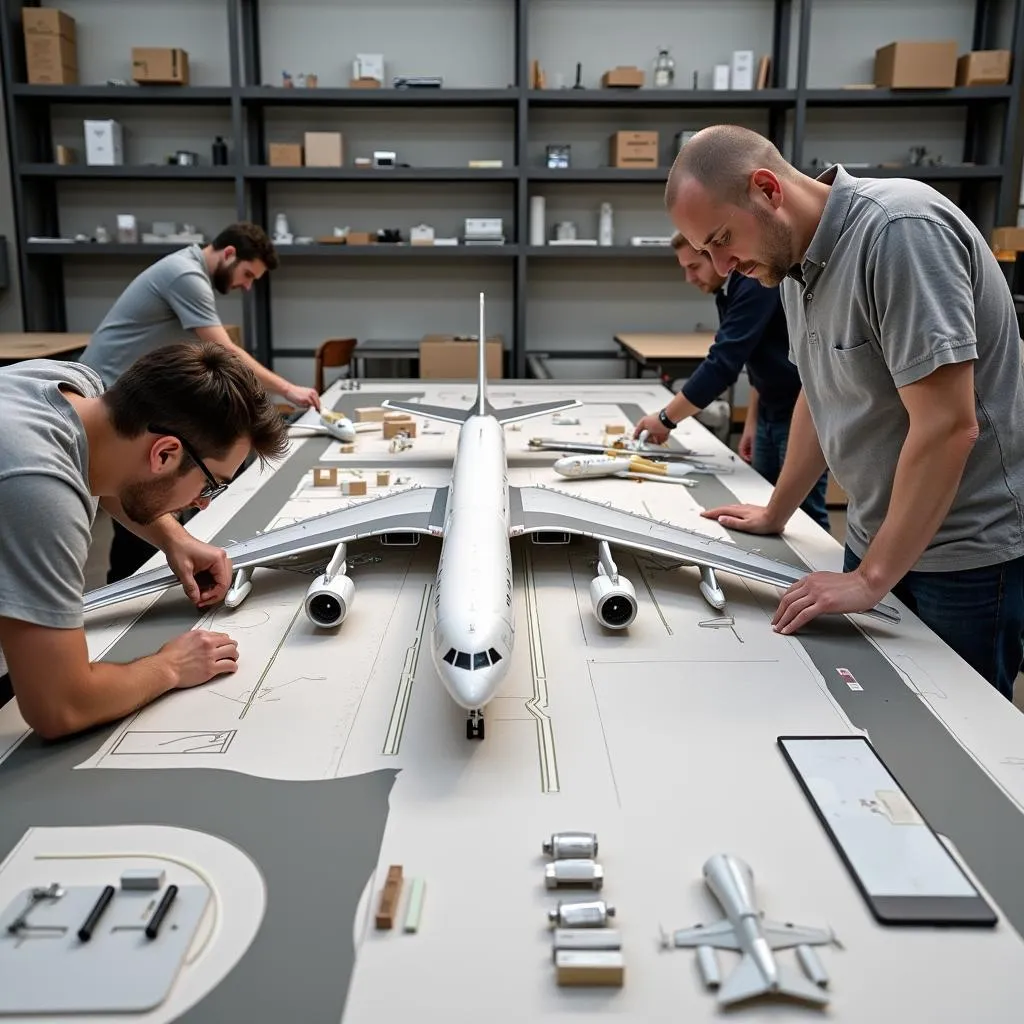Airport Model Projects are intricate representations of airports, encompassing everything from runways and taxiways to terminals and surrounding infrastructure. These models serve a multitude of purposes, from architectural design and engineering analysis to educational displays and public engagement.
 Airport Model Project Example
Airport Model Project Example
The Importance of Airport Model Projects
Airport model projects play a crucial role in the planning, design, and construction phases of airport development. They provide a tangible, three-dimensional visualization of the proposed airport, enabling stakeholders to understand the spatial relationships between different elements and identify potential issues before construction begins.
For instance, an airport model project can help architects and engineers assess the following:
- Runway and Taxiway Layout: Optimizing runway configuration for efficient aircraft movement and minimizing ground delays.
- Terminal Design and Passenger Flow: Evaluating terminal layouts to ensure smooth passenger flow and minimize congestion.
- Ground Support Equipment (GSE) Circulation: Analyzing GSE routes and parking areas to prevent conflicts and improve operational efficiency.
- Airspace and Obstruction Analysis: Identifying potential obstacles and ensuring compliance with airspace regulations.
 Airport Model Construction
Airport Model Construction
Types of Airport Model Projects
Airport model projects vary in scale, complexity, and purpose. Some common types include:
- Conceptual Models: Used in the early stages of planning to explore different design options and gather feedback from stakeholders. These models are typically made from simple materials like foam, cardboard, or 3D-printed components.
- Design Development Models: More detailed models used to refine the design, evaluate material choices, and communicate the project’s aesthetic vision. These models may incorporate a wider range of materials, including wood, acrylic, and metal.
- Construction Models: Highly accurate models used during the construction phase to coordinate different trades, resolve on-site issues, and ensure that the final product meets the design specifications. These models are often built to scale and may include working components like lighting and signage.
- Presentation Models: Used for marketing, public relations, and educational purposes. These models are typically finished to a high standard and may incorporate interactive elements like lighting, sound, and digital displays.
Benefits of Using Airport Model Projects
Airport model projects offer numerous benefits, including:
- Improved Communication and Collaboration: Facilitate clear communication between architects, engineers, contractors, and other stakeholders.
- Enhanced Design Visualization: Provide a tangible representation of the design, allowing for better understanding and evaluation.
- Early Problem Identification and Resolution: Help identify and address potential design flaws or operational challenges before construction.
- Cost and Time Savings: By identifying and resolving issues early, model projects can help prevent costly rework and delays during construction.
- Enhanced Public Engagement: Engaging the public and gathering feedback on proposed airport developments.
Airport Model Project Case Studies
Numerous airports worldwide have utilized model projects to aid in their development. For instance:
- Jewar Airport Construction Update: The construction of Noida International Airport (Jewar Airport) in India involved extensive use of model projects to plan and execute the complex design.
- Bangalore Airport Architect: The design of Kempegowda International Airport (Bangalore Airport) relied heavily on model projects to optimize passenger flow and terminal layout.
Creating an Airport Model Project
Developing a successful airport model project requires careful planning and execution. Here’s a step-by-step guide:
- Define the Project Scope: Determine the purpose of the model, the level of detail required, and the target audience.
- Gather Data: Collect all relevant information, including site plans, architectural drawings, and engineering reports.
- Choose a Scale: Select an appropriate scale for the model based on the available space and the level of detail required.
- Select Materials: Choose materials that are durable, easy to work with, and accurately represent the real-world counterparts.
- Build the Model: Construct the model using a combination of traditional model-making techniques and modern technologies like 3D printing.
- Add Details: Incorporate details like landscaping, signage, and lighting to enhance realism and improve communication.
- Review and Refine: Regularly review the model throughout the process to ensure accuracy and make necessary adjustments.
 Airport Model Details
Airport Model Details
Conclusion
Airport model projects are essential tools for airport planning, design, and construction. They facilitate communication, enhance visualization, and enable early problem identification, ultimately leading to more efficient and successful airport developments. As technology advances, we can expect to see even more innovative uses of model projects in the future, further improving the airport experience for passengers and stakeholders alike.
FAQs
1. What is the typical cost of an airport model project?
The cost of an airport model project varies widely depending on the scale, complexity, and materials used. Simple models can cost a few thousand dollars, while large, highly detailed models can cost hundreds of thousands of dollars.
2. How long does it take to build an airport model project?
The construction time for an airport model project depends on its size and complexity. Small models can be built in a few weeks, while large models can take several months to complete.
3. What are some of the challenges of creating an airport model project?
Some challenges include maintaining accuracy at scale, selecting appropriate materials, and incorporating intricate details.
4. What are the future trends in airport model projects?
Future trends include increased use of 3D printing, virtual reality integration, and the incorporation of real-time data feeds.
5. Where can I find more information about airport model projects?
You can find more information on airport model projects from architectural firms specializing in airport design, online resources dedicated to model making, and industry publications focused on aviation and airport development.
For further insights on related topics, explore our articles on:
Need assistance with your airport model project or have any aviation-related inquiries? Contact us at +13089626264, email us at [email protected], or visit our office at 404 Bothwell St, Oxford, NE 68967, USA. Our dedicated customer support team is available 24/7 to assist you.

